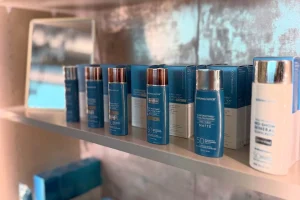
Let’s be honest. Your skincare routine is probably more than just a way to fight wrinkles. It’s a ritual. A moment of calm. That sigh of relief when you smooth on a cool gel or inhale a calming scent at the end of a long, frazzling day.
Well, what if that feeling wasn’t just a pleasant side effect? What if your products were scientifically designed to lift your spirits, calm your nerves, and genuinely make you feel happier? That’s the promise—and the fascinating science—behind neurocosmetics.
Beyond the Surface: What Are Neurocosmetics, Really?
Neurocosmetics, sometimes called psychodermatology or emotional skincare, is a relatively new frontier where beauty and neuroscience collide. It goes beyond just making your skin look good. It’s about formulating products that make you feel good by actively influencing your mood and mental state.
Think of it this way: traditional skincare talks to your skin. Neurocosmetics talks to your skin and your brain.
The core idea hinges on the intimate connection between your skin and your nervous system. They actually develop from the same embryonic layer in the womb. This shared origin story means they’re in constant, direct communication. Your skin is packed with sensory receptors that send signals straight to your brain. Neurocosmetic ingredients are designed to target those very pathways.
The Science of Feeling Good: How Mood-Boosting Skincare Works
So, how does a cream or serum pull this off? It’s not magic, though it can feel like it. The mechanisms are pretty clever and generally fall into a few key categories.
1. The Power of Scent (Aromachology)
This is the most direct route to your brain. When you inhale a fragrance molecule, it travels up your olfactory nerve and lands right in your limbic system—the brain’s command center for emotion and memory. This is why a whiff of lavender can be so instantly calming, or a burst of citrus can feel energizing.
Neurocosmetics leverage this with precision. You won’t just find generic “perfume” here. You’ll find targeted essential oil blends and synthetic neuro-fragrances designed to trigger specific emotional responses.
2. The Sensorial Experience
Texture matters. A lot. The physical sensation of a product on your skin sends powerful feedback to your brain. A cooling, tingling mask can feel invigorating and wake you up. A rich, buttery balm can feel deeply comforting and secure, like a weighted blanket for your face.
Formulators use ingredients that create these specific tactile sensations—think of the refreshing chill of menthol derivatives or the velvety cushion of certain silicones. It’s all about crafting a moment of pure, tactile pleasure.
3. Active Neuro-Ingredients
This is where it gets really sci-fi. Some ingredients are believed to interact with biochemical pathways linked to stress and well-being. For instance, certain peptides might mimic endorphins, those “feel-good” chemicals your body naturally produces. Others may help regulate cortisol, the primary stress hormone.
While research is still evolving, the potential is huge. We’re seeing ingredients like:
- Adaptogens (like ashwagandha or rhodiola in topical form) that may help skin—and by extension, you—better cope with stress.
- Cannabidiol (CBD), known for its purported calming and anti-inflammatory properties.
- Specific peptides and botanicals that target the skin’s own “endocannabinoid system,” a complex network involved in maintaining balance.
Building Your Own Mood-Altering Routine
Honestly, you don’t need to throw out your entire skincare cabinet. The beauty of this trend is that you can be strategic. It’s about choosing one or two products that serve as emotional anchors in your day. Here’s a simple way to think about it based on your needs.
| If You Need… | Look For… | Product Ideas |
| A Morning Energy Boost | Bright, citrusy scents (bergamot, orange); lightweight, cooling gels; invigorating textures. | Vitamin C serums with a citrus aroma; gel-based moisturizers; facial mists. |
| Evening De-Stress & Calm | Lavender, chamomile, sandalwood scents; rich, comforting cream textures; warming sensations. | Night creams with lavender; balm-to-oil cleansers; masks with calming adaptogens. |
| Comfort & Anxiety Relief | Weighted-feel balms; oat or CBD extracts; neutral, soft, or slightly sweet scents. | Barrier repair creams; facial oils; rich moisturizers with colloidal oatmeal. |
A Word on the Hype (And What to Really Expect)
Okay, let’s get real for a second. Neurocosmetics isn’t a substitute for therapy or medical treatment for anxiety or depression. The effects are subtle. It’s about mood modulation, not a complete transformation.
Think of it as a tool for mindfulness. The very act of taking two minutes to massage a beautifully scented cream into your skin forces you to pause and be present. That, in itself, is a powerful anti-stress practice. The product just enhances that moment.
And, you know, the placebo effect is probably at play here too. But if a product makes you feel more radiant and calm, does it truly matter if it’s purely biochemical or partly psychological? The result is the same: you feel better.
The Future is Feeling
We’re moving towards a future where wellness and beauty are utterly inseparable. The question is shifting from “Does this make me look younger?” to “How does this make me feel?” Neurocosmetics sits right at the heart of that shift. It acknowledges that our skin isn’t just a canvas to be painted—it’s a living, feeling organ, deeply wired to our inner emotional world.
So the next time you reach for a serum, pay attention. Does its scent transport you? Does its texture bring a moment of quiet joy? That’s not an accident. It’s a small, daily reminder that caring for your skin is, fundamentally, a profound way of caring for yourself.








